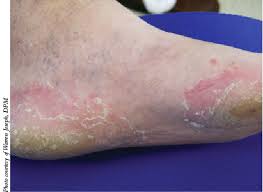Athlete’s Foot (Tinea Pedis)
Athlete’s Foot (Tinea Pedis) is a common fungal infection of the skin. The fungus is contagious, and easily spread between people by walking on shared surfaces such as bathrooms, communal showers, gym and pool change rooms. It can also be spread by wearing contaminated shoes, stockings or socks. Some people seem to be more prone to the infection than others.
During warmer weather, the incidence of tinea will increase as the infecting organisms thrive on warm and moist environments (such as the feet). Tinea pedis is one of the most common fungal infections of the skin. It may last for a short or long time and may recur after treatment.
Your risk for getting athlete’s foot increases if you:
- Wear closed shoes without socks, especially if they are synthetic-lined
- Have your feet wet for extended periods of time
- Are prone to sweating
- Have a minor skin or nail injury
- Signs and symptoms: Sensations of itching, burning, or stinging
- Redness
- Generalised dryness
- Scaling/flaking and peeling skin, rash on the sole of feet
- Scaling/flaking/peeling/moist sloughing skin between toes, often between the fourth and fifth toes.
Treatment
The treatment for tinea pedis will be determined by the type and severity of tinea you have. It is best to seek advice from your podiatrist for the most effective therapy.
While most fungal infections can be treated fairly easily, others can be extremely stubborn and difficult to get rid of. In rare cases fungal infections can even become chronic. There are a lot of treatments available out there for fungal infections which include everything from over the counter creams, sprays and powders, right through to prescription medications.
At Foot Solutions, our Podiatrists can help recommend appropriate anti-fungal medication to assist in removing the infection, and provide advice to prevent a re-occurrence of the infection. If the fungus has caused your skin to flake and peel, we can clean that up too.
Prevention
The best ways to prevent tinea on your feet include keeping your feet clean and dry, particularly between the toes. Tinea infections love moisture so avoid letting your feet become overly wet or sweaty by wearing moisture-wicking socks such as cotton and make sure you change your socks regularly.
In communal areas such as gym or swimming pool change rooms and shower areas, wear thongs to reduce the risk of your feet picking up a fungal infection. To prevent cross-contamination, avoid sharing towels with other people and wash your hands thoroughly after touching any infected areas.
If you think you may have Tinea Pedis, or would like more advice on this condition, please book a consultation with one of our podiatrists.
“The content of this information is provided for general information purposes only. Foot Solutions does not accept any liability to any person for the information or advice (or the use of such information or advice), which is provided or incorporated into it by reference. The information is provided on the basis, that all persons using such information take responsibility for the relevance of its content. This information should be used in conjunction with medical professional advice or treatment.



